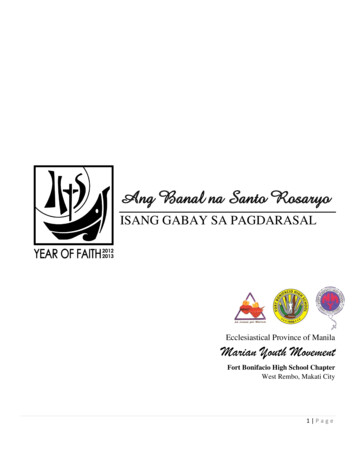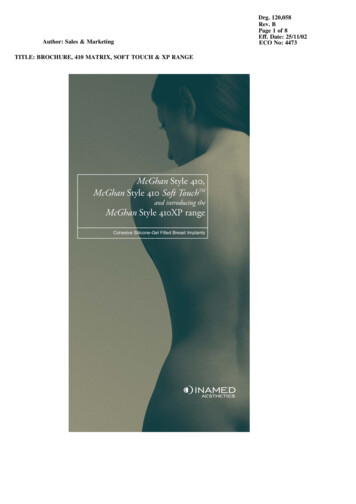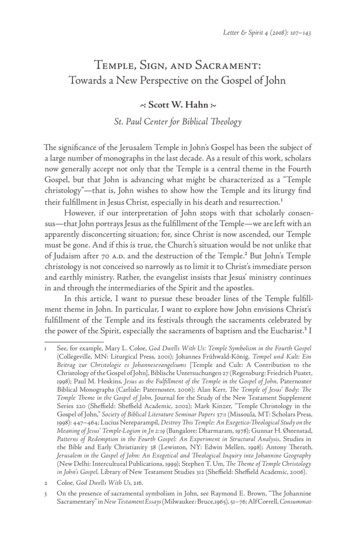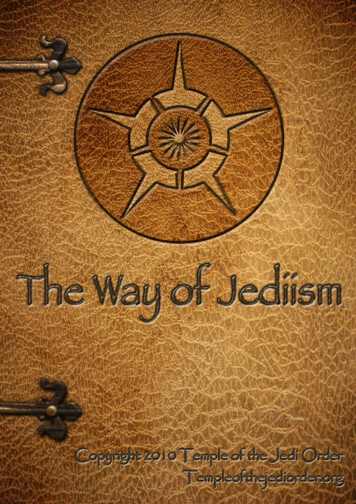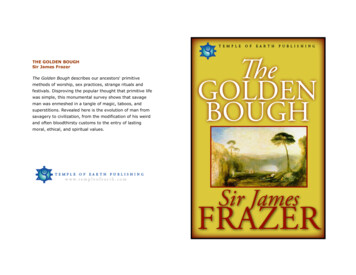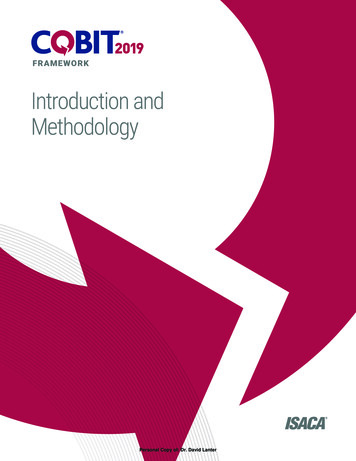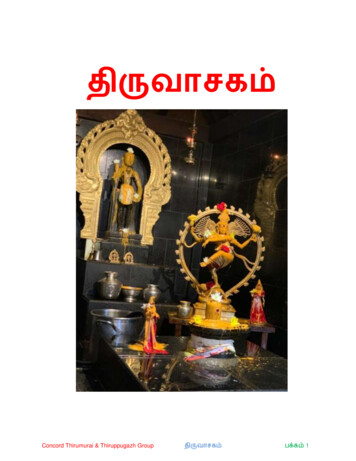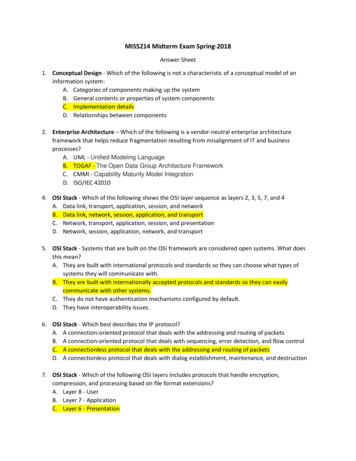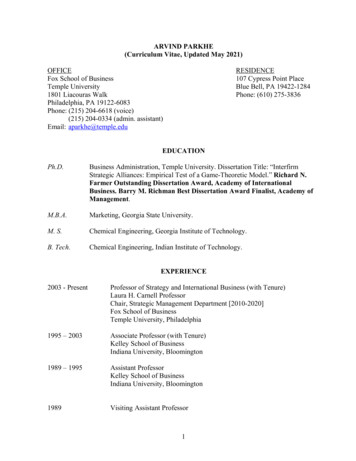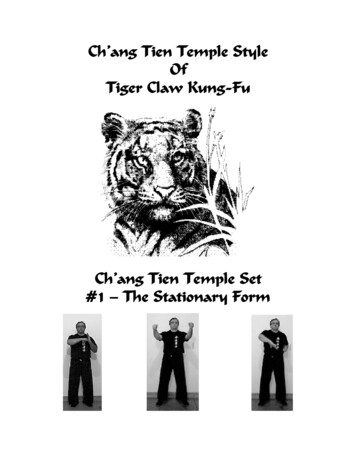
Transcription
Ch’ang Tien Temple StyleOfTiger Claw Kung-FuCh’ang Tien Temple Set#1 – The Stationary Form
Ch’ang Tien Temple Set #1 – The Stationary FormHEALTH RISK ADVISORYIt is important that you see yourphysician, or health care specialistBefore beginning any type ofExercise program.DISCLAIMERThe authors and publishers of this textassume no legal or financialresponsibility either direct or impliedthat may result from theUse, abuse, or misuse of theInformation contained herein.The information contained herein isProtected by U.S. & InternationalCopyright Laws Ronald J Shively 20032
Ch’ang Tien Temple Set #1 – The Stationary FormAcknowledgements:This text would not be possible if it were not for the individuals who greatly enhanced my yearsof study through their encouragement.To my wife Sandra K. Shively, who helped me cut through all the mess.To Anthony Sandoval, Grand Master of American Hakutsuru/White Crane for his personalinstruction and insight Also the top student of the late William “Eagle” Dong,the Grand Master of the Fukien White Crane System of Shaolin Kung-Fu.To Robert K. Markorre Cooper, Inheritor-Successor of the Tibetan Charging White Cranesystem.To Michael Taicher, Bob Cooper’s assistant instructor, who owned and operated the SpectrumHealth Center – Lightning Fire Mountain Tibetan-Chinese Gung-fu Association.To Cardin Shannach, who helped fill in a lot of the blanks concerning both the Tibetan andChinese martial arts.To my many instructors who willingly shared what they knew with me you helped fill in thegaps.To my many friends, and students throughout the U.S.A. and abroad who willingly gave ofthemselves to both learn and train under me you were all essential to my growth.All photos and written material used within this text are being used with permission. Ronald J Shively 20033
Ch’ang Tien Temple Set #1 – The Stationary FormTable of Contents:Page#1) Introduction2) A Personal Note 3) IMPORTANT!4) The Origin of Lion’s Roar/Tibetan White Crane Kung-Fu5) The Origin of Ch’ang Tien Temple Tiger Claw Kung-Fu6) The Ape’s Identity689101215The Ch’ang Tien Temple Set – The Stationary Form17Training Sequences –#1 The Opening Salutation#2 - Circling Both Arms#3 – Rising Up, Ripping Down#4 - Circling Double Palms Strike & Retracting Tiger Claws#5 - Over & Under Spear Hands#6 - Ape Circling its Arms#7 - Tiger Palm Claw & Punch - right & left side#8 Ape Strikes the Tiger – right & left side#9 Tiger Strikes Back – right & left side#10 Ape & Tiger Fight Together – right & left side#11 Double Hand Strikes & Close31323334353637-4142-4445-5051-5455-59Chi Gung ExercisesUnderstanding Chi FlowCircling Both Arms – forwardsCircling Both Arms – backwardsChi Diffusing Drill(s)61-64656667Technical BreakdownStrikesWrist LocksJoint Locks/Takedowns/ThrowsSweep & Throws69-116Final Comments117 Ronald J Shively 20034
Ch’ang Tien Temple Set #1 – The Stationary Form1) Introduction2) A Personal Note 3) IMPORTANT!4) The Origin of Lion’s Roar/Tibetan White Crane Kung-Fu5) The Origin of Ch’ang Tien Temple Tiger Claw Kung-Fu6) The Ape’s Identity Ronald J Shively 20036891012155
Ch’ang Tien Temple Set #1 – The Stationary FormIntroductionThe Ch’ang Tien Temple Set is a Chinese Kung-Fu form that belongs to the Tiger Claw KungFu style within the Chinese martial arts system known as SHAOLIN.Shaolin TempleSpecifically, the Ch’ang Tien Temple was an actual Shaolin Temple within South WesternChina. Residing close to the Himalayan Mountains, and also bordering alongside Tibet, theCh’ang Tien Temple System developed an entirely different method of self-defense. Ronald J Shively 20036
Ch’ang Tien Temple Set #1 – The Stationary FormWith a strong influence of Tibetan Lion’s Roar, Tibetan White Crane Kung-Fu, Lama & HopGar Kung-Fu (among others), the Ch’ang Tien Temple System developed in the mountainousand rugged hills, mountains and valleys of the Himalayas.Because the terrain was extremely rocky and uncertain, strong hand techniques were developedover kicking techniques. However, this does not mean that there are no kicks within the Ch’angTien Temple System.Not unlike many of the more traditional combative sets, forms, or kata that are practicedthroughout Asia, kicking and/or leg techniques were often “implied” and not actually specified.By this I mean that if there was an opportunity to use a kick and/or leg techniques within a set,form, or kata it could be easily inserted.Therefore, the adding of kicks, joint locks, throws, pressure point strikes, and weapons wasbased upon an individual’s level of understanding of the form, set, or kata.The form, set, or kata within these pages is the first part of a three-part form. The first part dealsmainly with fighting from a stationary position, the second part deals with dual hand techniques,while the third part allows the student to travel or step along the lines of a BOX pattern.Originally, the Ch’ang Tien Temple Set was one long form of both the stationary patterns andthe box stepping pattern. However, for ease of instruction, the form was divided into the threemain parts: The Stationary Set, The Dual Hand Set, & the Box Set.Within the Ch’ang Tien Temple Set you will find almost every type of punching and/or strikingtechnique that is known within the martial arts. In addition to the striking techniques, you willalso find a lot of circular hand movements that work well within Chin-Na, Ju-Jitsu, or Grappling(joint locking & throwing).As you study the form, keep in mind that the Ch’ang Tien Temple Set is A COMPLETESYSTEM! By this I mean that your level of combative knowledge/skill will provide you with anexcellent resource for “unlocking” the hidden potential within this form, set, or kata.Best Of LuckRon Shively Ronald J Shively 20037
Ch’ang Tien Temple Set #1 – The Stationary FormA Personal Note I first learned this form, set, or kata – The Ch’ang Tien Temple Set in the late 1970’s while beingstationed at Ellsworth AFB, South Dakota – outside of Rapid City, South Dakota.My instruction was at a martial arts school known as Spectrum Health Center, which also wasknown as the Lightning Fire Mountain School – Tibetan Chinese Gung-Fu Association. Therewere four (4) main styles of Chinese Kung-Fu taught at the school: Tibetan Charging White CraneCh’ang Tien Temple Tiger ClawNorthern Dragon Style, andShanghai Cobra Hand Style.My two instructors were Robert K. “Markorre” Cooper, and his assistant Michael Taicher.Sifu Cooper learned this system from a Tibetan immigrant named Chou Dieh Hsiang, who hadbeen a student of the Tibetan monk Kangsar Ming.Ming had developed the Charging White Crane system after many years of study in the TibetanPure White Crane system. Ming had taught only one student – Chou Dieh Hsiang.Chou studied with Ming for more than 20 years, until Ming’s death and inherited the systemfrom him. From there he went on a 10 - year pilgrimage throughout China, learning the otherremaining systems. First learning the Ch’ang Tien Temple Tiger Claw System, second, theNorthern Dragon Style, and finally the Shanghai Cobra Hand Style.Chou returned to Tibet and lived there until the Communist takeover, where he was the lonesurvivor of his family that escaped. Emigrating to the West, Chou first stayed in Hong Kong,then the United States. Finding modern living to be unsettling, Chou finally moved to a smallMexican village just outside the US – Mexican border. It was there that Chou met Robert K.“Markorre” Cooper.While being stationed as a Self-Defense Instructor for the US Marine Corps, Bob Cooper wasable to learn all four styles from Chou Dieh Hsiang. Sifu Cooper’s knowledge of these systemsbecame known as the Lightning Fire Mountain School.***IMPORTANT***While there were several of us who trained as students under both Bob Cooper and MikeTaicher, to my knowledge no one in the US still claims to either know or teach all four styles, orany part of the Lightning Fire Mountain School system. This manual is an attempt to document asmall portion of the training that I received while residing in Rapid City, South Dakota manyyears ago. Ronald J Shively 20038
Ch’ang Tien Temple Set #1 – The Stationary FormIMPORTANT!Please keep in mind that many of these stories, myths, and legends concerning the developmentof this specific style of martial arts are just that – STORIES!They are not meant to be used for a factual-historical basis.They are at best a source of information that seeks only to be entertaining, and not necessarilyused for enlightenment.After reading this text, it is up to you - the reader - to decide as to whether to accept any part orportion of it. Ronald J Shively 20039
Ch’ang Tien Temple Set #1 – The Stationary FormThe Origin of Lion’s Roar/Tibetan White Crane Kung-FuUsed With PermissionAccording to legend, Lion's Roar was created by a martial artist and Buddhist Lama named AhDat-Ta. Ah Dat-Ta is also sometimes known as the "Dai Dat Lama".Ah Dat-Ta was born in 1426 and was a member of a nomadic tribe that traveled throughout Tibetand Chinghai. He was an active young man who practiced horsemanship, wrestling (Shuai-Jiao)and a special type of Chin-Na (seizing and controlling skill). After being ordained as a monk inTibet, he also learned a martial art that was apparently Indian in origin.For several years Ah Dat-Ta retreated to the mountains to live in seclusion, studying Buddhisttexts and practicing meditation. He also hoped to improve his martial art skill. One day Ah DatTa's meditation was disturbed by a loud sound. He left the cave he had been meditating in toinvestigate and found an ape trying to capture a crane. He was astonished. Despite the ape's greatsize and strength, the crane eluded the great swings and pecked at soft, vital points. Ah Dat-Tawas inspired to create a new martial art. Ronald J Shively 200310
Ch’ang Tien Temple Set #1 – The Stationary FormAh Dat-Ta created a system that mimicked the deft evasion and vital point striking of the whitecrane and the ape's powerful swings and grabbing techniques. It was based upon the numbereight, an important number in Chinese cosmology and numerology. The fundamental fightingtheory was known as the "eight character true essence". The "eight character true essence" can beroughly translated as "strike the place that has a pulse, never a place that has no pulse, andstretch the arms out while keeping the body away".The system consisted of 8 fist strikes, 8 palm strikes, 8 elbow strikes, 8 finger strikes, 8 kickingtechniques, 8 seizing (clawing) techniques, 8 stances and 8 stepping patterns. It includedtechniques derived from a wide variety of influences including Mongolian wrestling (ShuaiJiao), Northern and Western Chinese long arm and kicking techniques, and Tibetan and Indianclose range hand techniques and evasive footwork. Ronald J Shively 200311
Ch’ang Tien Temple Set #1 – The Stationary FormThe Origin of Ch’ang Tien Temple Tiger Claw Kung-FuUse With PermissionAccording to legend, the origin of the Ch’ang Tien Temple Tiger Claw system is based upon astory that was told throughout the style. The monks of the Ch’ang Tien Temple were known fortheir skill in martial arts.It is said that a young boy, a novice – servant to the monks of the Ch’ang Tien Temple wasperforming his daily duties outside the walls of the temple. One of his duties or tasks was tocarry buckets of water from the river back to the cistern so that the monks would have water todrink.During one of his tasks the young boy saw a group of tigers moving past the walls of the temple.Calling out to the monks inside the temple to come and see this unusual sight, the monks stoppedtheir training in martial arts to watch the animals move through the clearing that surrounded thetemple. This was indeed a rare sight in that no one could remember ever seeing a tiger this closeto the temple, or to have seen a group of tigers together.It was at this moment that an ape came out of the forest, blocking the path of the oldest tiger.The monks knew that both creatures – the tiger and the ape – rarely saw each other in the wild,and that both were powerful animals and could be fierce fighters on their own. Both tiger and apecircled each other, until the ape lunged toward the elderly tiger, striking the large cat with hislong arms and rock hard fists.At first the monks believed that the ape would succeed in killing the tiger, but the big cat quicklyrecovered from the blows and used his razor sharp claws and teeth to rip and tear at the ape’slimbs. The pitched battle between tiger and ape went on for several minutes until both animalswere severely wounded and the ape chose to leave the tigers in the temple clearing to tend to hisown wounds. It was at this time that the tigers walked off into the forest.The monks stopped to reflect on the battle that just took place outside their walls. It was then thatone of the monks spoke up saying, “I believe that the battle we just saw between tiger and apewas divinely inspired! That Heaven has given us instruction into a new type of martial arts!” Ronald J Shively 200312
Ch’ang Tien Temple Set #1 – The Stationary FormAll of the other monks quickly agreed that indeed this was not just a chance happening. That thebattle between tiger and ape was not just an omen, or a sign, but was designed to give instructionto the monks who lived and trained in martial arts at the Ch’ang Tien Temple.It is said that from the observation and the recording of this battle between tiger and ape by themonks that the style known as the Ch’ang Tien Temple style was created.Chou Dieh Hsiang, who had been a student of the Tibetan monk Kangsar Ming, added theCh’ang Tien Temple Tiger Claw Style to his own style of Tibetan Charging White Crane.***During my training at the Lightning Fire Mountain School, I asked as to why there was no fifthanimal in their curriculum. The reason for my question was that traditional Shaolin Kung-Fu wascomprised of five (5) animals:1.
Tibetan Charging White Crane Ch’ang Tien Temple Tiger Claw Northern Dragon Style, and Shanghai Cobra Hand Style. My two instructors were Robert K. “Markorre” Cooper, and his assistant Michael Taicher. Sifu Cooper learned this system from a Tibetan immigrant named Chou Dieh Hsiang, who had been a student of the Tibetan monk Kangsar Ming. Ming had developed the Charging .
